Again, downwards movement was expected for the week, which is what has happened.
Summary: This downwards swing may now continue to about 61.22. For the very short term, look out for a bounce to end about 72.12.
A deeper and longer lasting consolidation may be underway, which may last about 13 to 21 weeks in total. It should remain above 55.24, and the target is about 61.12. The consolidation will not move in a straight line; it may swing from resistance to support and back again in large swings. Once resistance and support are identified, then a swing trading system may be employed by more experienced traders. Support may now be about 63.0 and resistance may be about 75.25.
Always practice good risk management as the most important aspect of trading. Always trade with stops and invest only 1-5% of equity on any one trade. Failure to manage risk is the most common mistake new traders make.
New updates to this analysis are in bold.
MAIN WAVE COUNT
MONTHLY CHART
The bear market for US Oil looks to be over and a new bull market looks to be in its very early stages. The prior bearish wave count has been invalidated, leaving only this very bullish wave count.
A huge zigzag down to the last low may be complete and is labelled here Super Cycle wave (II).
Cycle wave b must be seen as complete in August 2013 for this wave count to work. It cannot be seen as complete at the prior major swing high in May 2011.
Cycle wave b is seen as a zigzag, and within it primary wave B is seen as a running contracting triangle. These are fairly common structures, although nine wave triangles are uncommon. All subdivisions fit.
Primary wave C moves beyond the end of primary wave A, so it avoids a truncation. But it does not have to move above the price territory of primary wave B to avoid a truncation, which is an important distinction.
If cycle wave b begins there, then cycle wave c may be seen as a complete five wave impulse.
Super Cycle wave (III) must move beyond the end of Super Cycle wave (I). It must move far enough above that point to allow room for a subsequent Super Cycle wave (IV) to unfold and remain above Super Cycle wave (I) price territory.
Cycle wave I may be incomplete. It may be unfolding as an impulse and may have now moved through the middle portion. Commodities have a tendency to exhibit swift strong fifth waves, and this tendency is especially prevalent for third wave impulses. Intermediate wave (5) to end primary wave 3 may be very swift and strong, ending with a blow off top.
When cycle wave I is complete, then cycle wave II may be a deep correction that may not move beyond the start of cycle wave I below 26.06.
Data from FXCM for USOil does not go back to the beginning of Super Cycle wave (I). Without an accurate known length of Super Cycle wave (I) a target cannot be calculated for Super Cycle wave (III) to end using Fibonacci ratios. The target for Super Cycle wave (III) may be calculated when cycle waves I, II, III and IV within it are complete. That cannot be done for many years.
WEEKLY CHART
Intermediate wave (3) may now be complete. There is no Fibonacci ratio between intermediate waves (1) and (3), and intermediate wave (3) is longer than 1.618 the length of intermediate wave (1).
This wave count fits with classic technical analysis at the monthly and daily chart levels.
Intermediate wave (2) was a deep double zigzag. Given the guideline of alternation, intermediate wave (4) may be expected to most likely be a shallow flat, triangle or combination. It may be about even in duration with intermediate wave (2), or it may be a little longer because triangles and combinations are more time consuming structures.
In the first instance, a Fibonacci 13 weeks may be expected for intermediate wave (4). If about that time the structure is incomplete, then the next Fibonacci number in the sequence at 21 will be expected. At this stage, it has lasted only 8 weeks.
Intermediate wave (4) may find support about the lower edge of the black Elliott channel. It may end within the price territory of the fourth wave of one lesser degree; minor wave 4 has its territory from 66.65 to 59.13.
DAILY CHART
Intermediate wave (4) may still be unfolding as any one of a flat, combination or triangle. This chart will encompass all three ideas. When the three ideas begin to diverge in the next week or so, then they may be published as separate charts.
If intermediate wave (4) is unfolding as a flat correction, then within it minor wave A was a completed zigzag and minor wave B was a completed expanded flat correction and a 1.27 length to minor wave A, which is within the most common range of 1 to 1.38. Minor wave C may now most likely reach about 1.618 the length of minor wave A. Minor wave C would be extremely likely to make at least a slight new low below the end of minor wave A at 64.22 to avoid a truncation and a very rare running flat.
If intermediate wave (4) is unfolding as a triangle, then within it minor wave A is a completed zigzag and minor wave B is a completed expanded flat correction. Four of the five sub-waves of a triangle must be single or multiple zigzags, leaving one triangle sub-wave which may be a flat correction. Only one triangle sub-wave may be a multiple zigzag, and minor wave C is the most likely triangle sub-wave to be a double zigzag. Minor wave C may not move beyond the end of minor wave A below 64.22 for a triangle.
If intermediate wave (4) is unfolding as a double combination, then minor wave W within it would be the first complete structure as a zigzag. Minor wave X may now be complete, joining the two structures within the double. Minor wave Y may be either a flat or triangle, and a flat is much more likely by a very wide margin. Minor wave Y may end about the same level as minor wave W at 64.22, so that the whole structure moves sideways.
The structures are incomplete for all three ides. More sideways movement would be expected, with final resistance about 75.25 and support about 63.50 or a bit below.
Intermediate wave (4) may not move into intermediate wave (1) price territory below 55.24.
ALTERNATE DAILY CHART
This alternate wave count is identical to the first daily chart above except for the degree of labelling within intermediate wave (4) which is moved down one degree.
Intermediate wave (4) may be unfolding as a double combination, with the first structure in a double an incomplete expanded flat correction labelled minor wave W. Double combinations are very common structures.
The short term expectation for some downwards movement about here is exactly the same for both wave counts.
TECHNICAL ANALYSIS
MONTHLY CHART
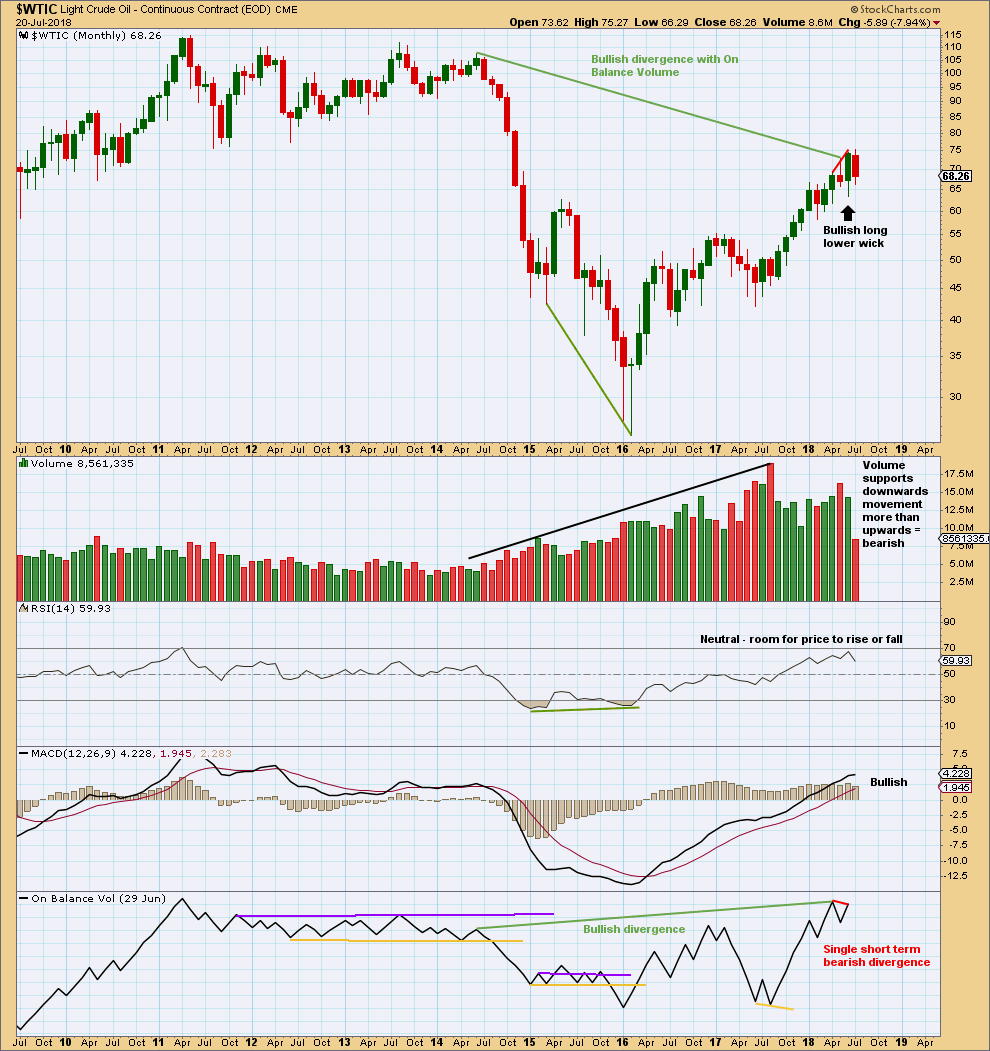
Click chart to enlarge. Chart courtesy of StockCharts.com.
The short term volume profile is bearish: the strongest month in the last few months was the downwards month of May (where the balance of volume was down) and now June shows a decline in volume, so volume has not supported upwards movement here.
For the short term, On Balance Volume is also slightly bearish. This supports the idea that price may be within a correction and not necessarily a continuation of the larger upwards trend.
However, it is entirely possible that this situation could reverse and volume could start to support upwards movement, as has happened back in January 2018.
The larger trend is upwards.
DAILY CHART
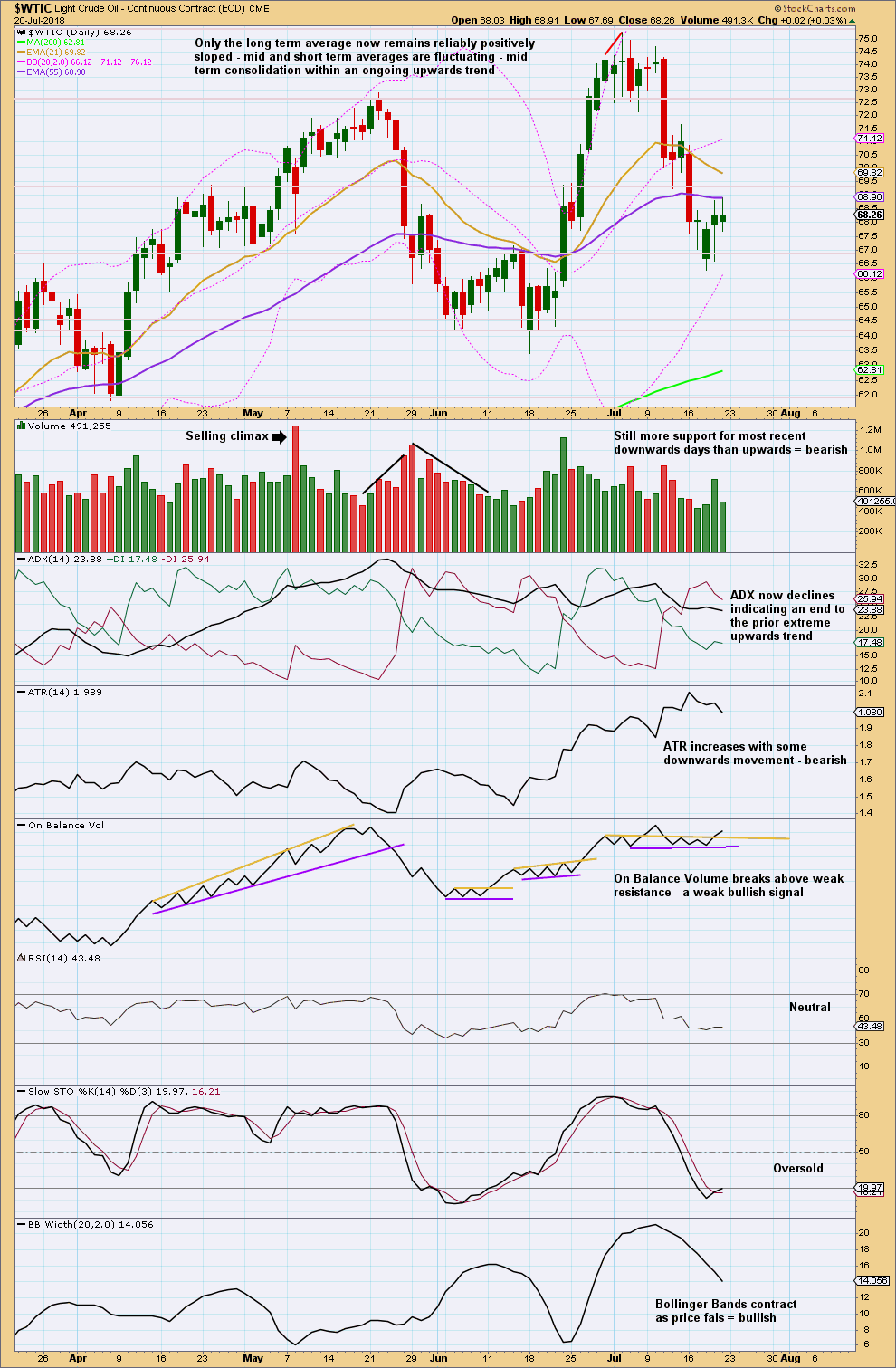
Click chart to enlarge. Chart courtesy of StockCharts.com.
ADX now indicates no clear trend; the market may be consolidating.
Expect swings from support to resistance and back again, using Stochastics to indicate when each swing may end.
Price has moved lower.
This looks like a downwards swing. There is some support here, at about 67.00. Look for a bounce here within the downwards swing. Thereafter, the swing may continue to the lower edge of support for this consolidation, which is about 64.00. If price gets down there and Stochastics is oversold and there exhibits bullish divergence with price, then look for the downwards swing to end an a new upwards swing to begin.
Published @ 11:02 p.m. EST on 21st July, 2018.

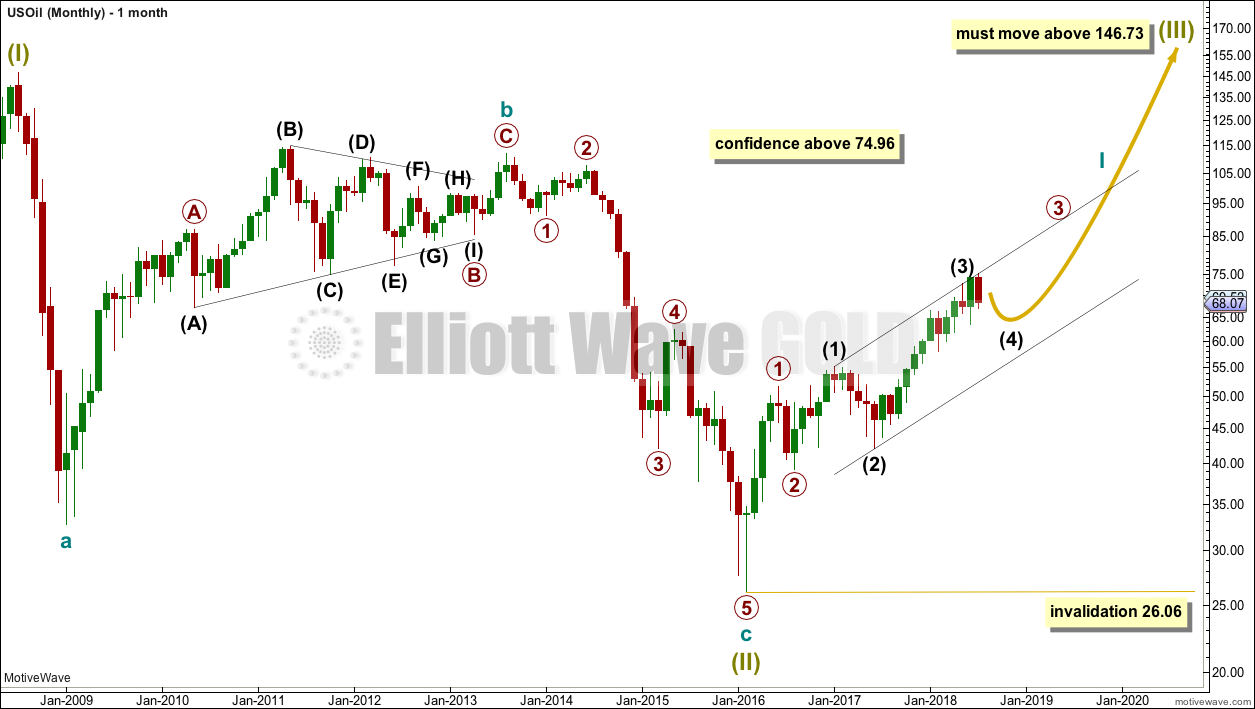
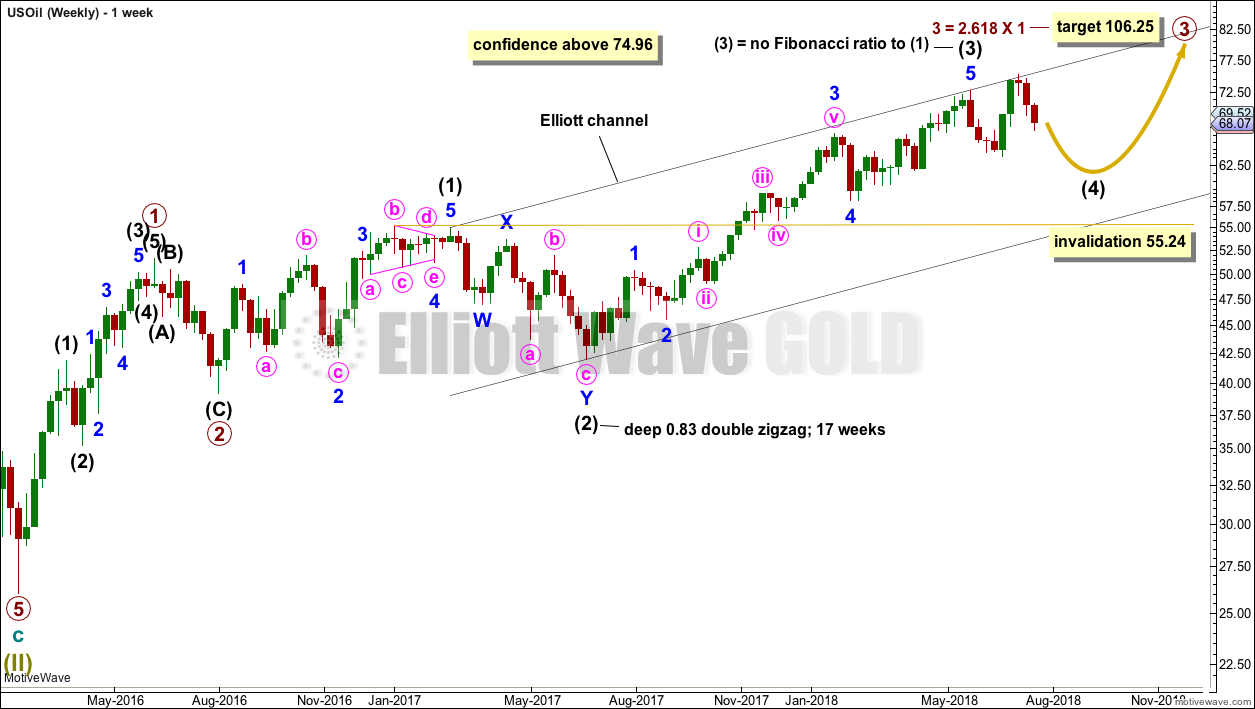
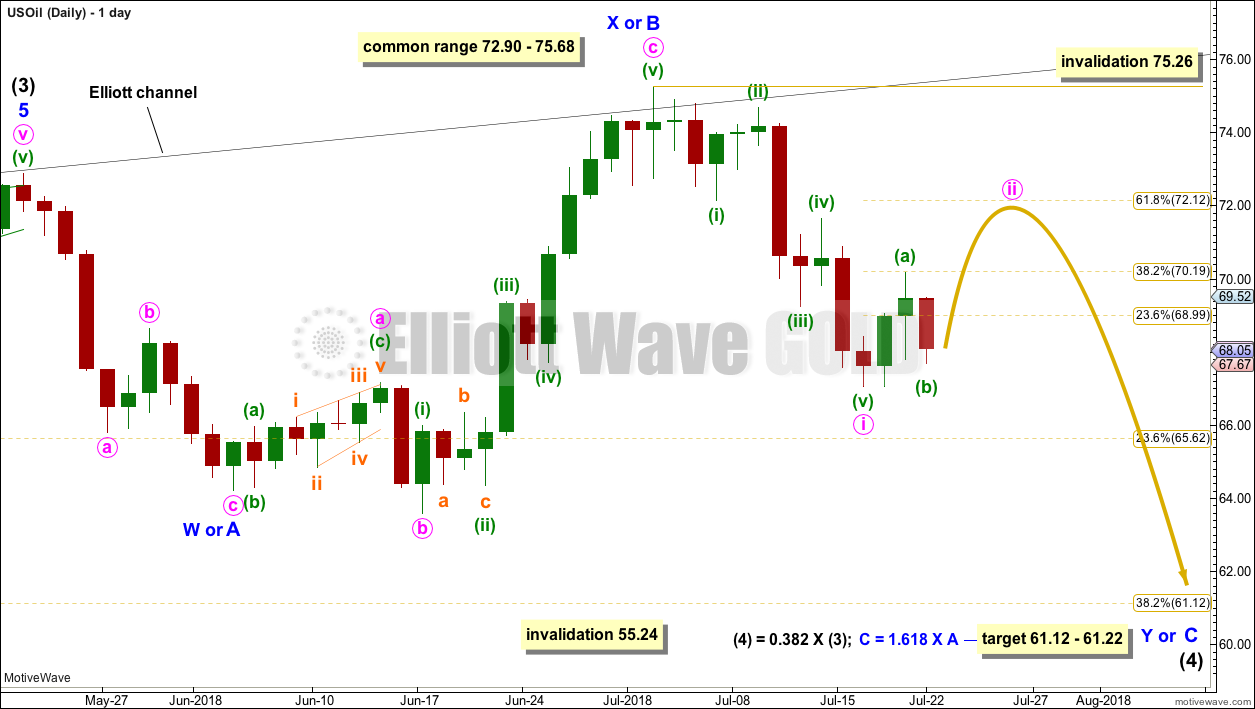
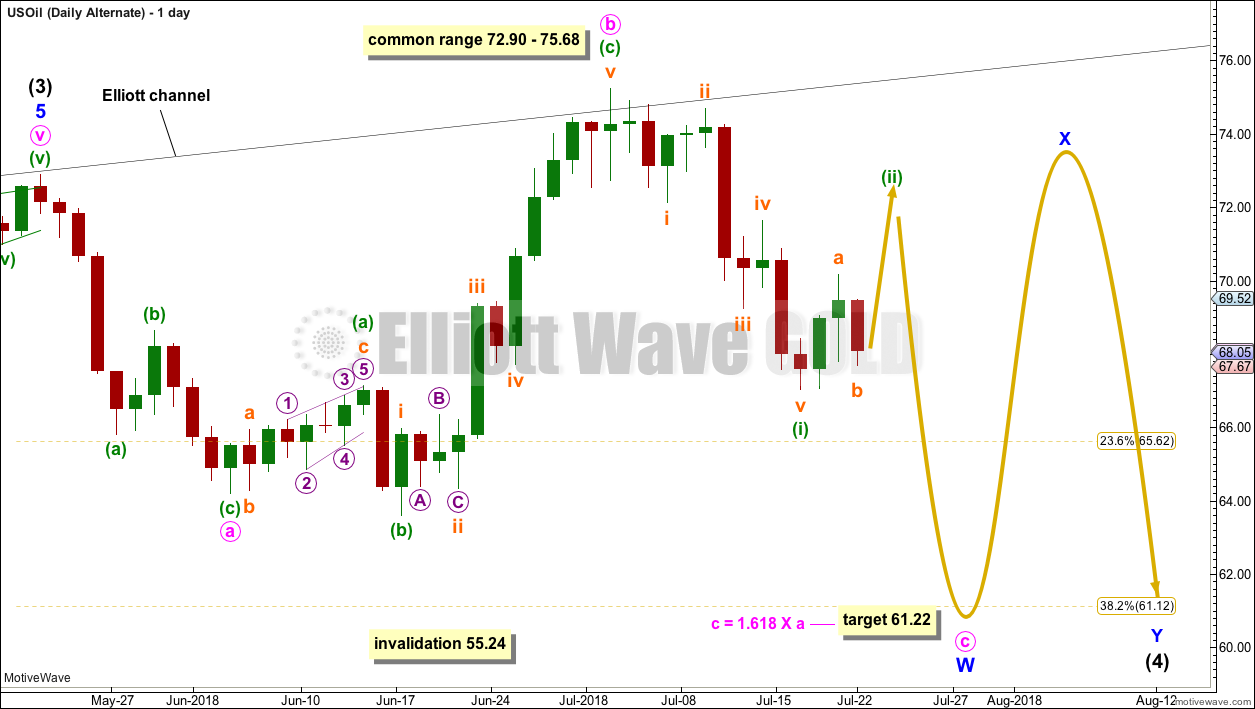
Hi Lara,
Do you think minute ii could be over at today’s high (38% retrace) or is the 62% retrace more likely based on EW.
Thanks